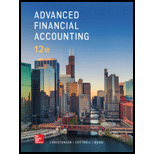
a.
Foreign exchange rate: The rate at which currency of one country is changed to currency of another country is called foreign exchange rate. Mainly there are two rate, i.e., direct exchange rate and indirect exchange rate.
Foreign exchange gain or loss: Foreign exchange gain or loss arises when there is selling or buying of any goods and services in foreign currency.
Forward contract: It is the contract between the purchase and the seller where they agreed to buy or sell an asset at a fixed price in the future on a specific date.
The recording of the
b.
Foreign exchange rate: The rate at which currency of one country is changed to currency of another country is called foreign exchange rate. Mainly there are two rate, i.e., direct exchange rate and indirect exchange rate.
Foreign exchange gain or loss: Foreign exchange gain or loss arises when there is selling or buying of any goods and services in foreign currency.
Forward contract: It is the contract between the purchase and the seller where they agreed to buy or sell an asset at a fixed price in the future on a specific date.
The effect on net income of A company if forward contract is made or if forward contract is not made.
Want to see the full answer?
Check out a sample textbook solution
Chapter 11 Solutions
EBK ADVANCED FINANCIAL ACCOUNTING
- Boston Industries completes job #842, which has a standard of 840 labor hours at a standard rate of $22.75 per hour. The job was completed in 890 hours, and the average actual labor rate was $23.10 per hour. What is the labor efficiency (quantity) variance? (A negative number indicates a favorable variance and a positive number indicates an unfavorable variance.)arrow_forwardPlease explain the solution to this general accounting problem with accurate principles.arrow_forwardI am looking for the correct answer to this general accounting question with appropriate explanations.arrow_forward
- Month Monthly Product Demand 2021-01-01 207.55 2021-02-01 208.25 2021-03-01 209.33 2021-04-01 210.11 2021-05-01 213.78 2021-06-01 225.12 2021-07-01 227.19 2021-08-01 218.92 2021-09-01 213.25 2021-10-01 210.75 2021-11-01 215.97 2021-12-01 223.97 2022-01-01 220.54 2022-02-01 213.47 2022-03-01 218.48 2022-04-01 222.07 2022-05-01 222.85 2022-06-01 236.38 2022-07-01 248.60 2022-08-01 234.45 2022-09-01 217.32 2022-10-01 222.56 2022-11-01 237.77 2022-12-01 245.59 2023-01-01 237.75 2023-02-01 213.70 2023-03-01 238.18 2023-04-01 244.78 2023-05-01 233.42 2023-06-01 241.35 2023-07-01 267.98 2023-08-01 249.97 2023-09-01 220.58 2023-10-01 233.12 2023-11-01 240.90 2023-12-01 268.61 2024-01-01 250.80 2024-02-01 225.31 2024-03-01 247.32 2024-04-01 248.50 2024-05-01 237.35 2024-06-01 258.62 2024-07-01 284.45 2024-08-01 256.21 2024-09-01 225.73 2024-10-01 234.07 2024-11-01 263.70 2024-12-01 286.03 Please…arrow_forwardAccounting 12 May I please have a brief summary highlighting one unique feature of the app, recommending it to Sadie—who wants to use some apps for her dog grooming salon to schedule grooming appointments? Thank you so much,arrow_forwardGiven solution for General accounting question not use aiarrow_forward
- Kindly help me with this General accounting questions not use chart gpt please fast given solutionarrow_forwardPlease given correct answer for General accounting question I need step by step explanationarrow_forwardQuiksilver Company sold 4,480 units in October at a price of $63 per unit. The variable cost is $51 per unit. Calculate the total contribution margin. A. $62,060 B. $73,080 C. $56,000 D. $99,750 E. $ 53,760 helparrow_forward
 Financial Reporting, Financial Statement Analysis...FinanceISBN:9781285190907Author:James M. Wahlen, Stephen P. Baginski, Mark BradshawPublisher:Cengage Learning
Financial Reporting, Financial Statement Analysis...FinanceISBN:9781285190907Author:James M. Wahlen, Stephen P. Baginski, Mark BradshawPublisher:Cengage Learning


